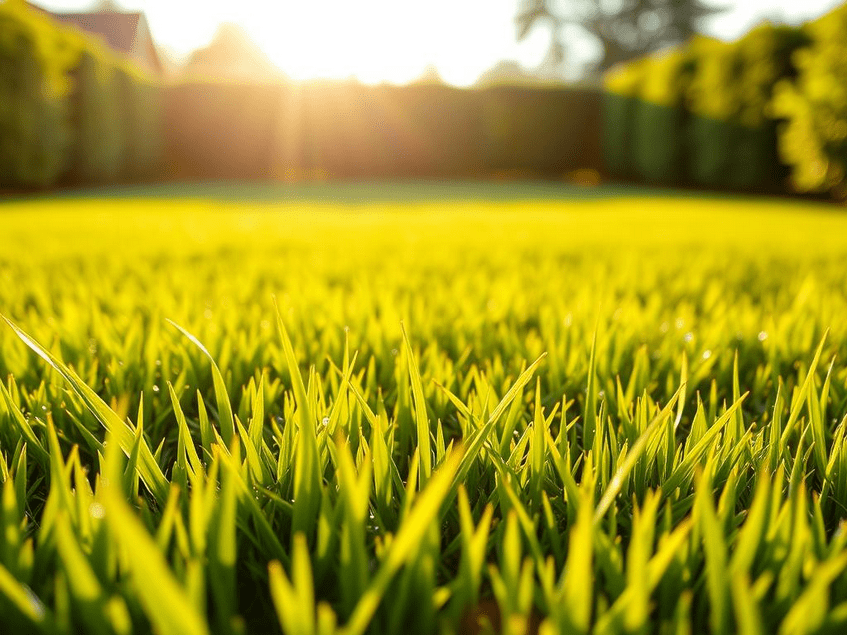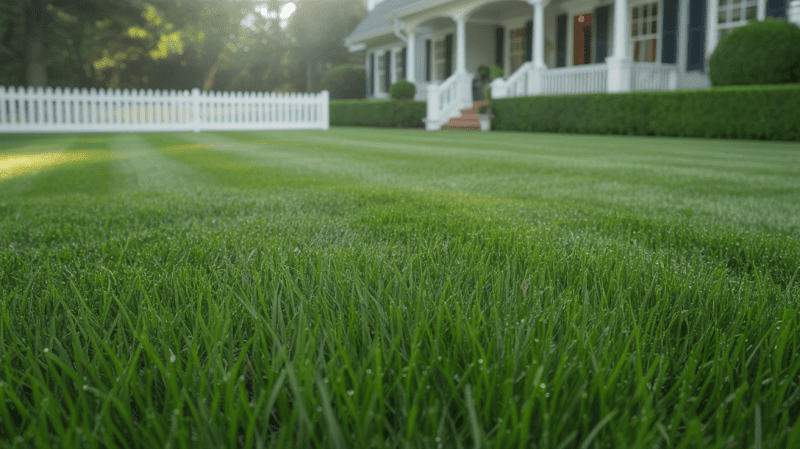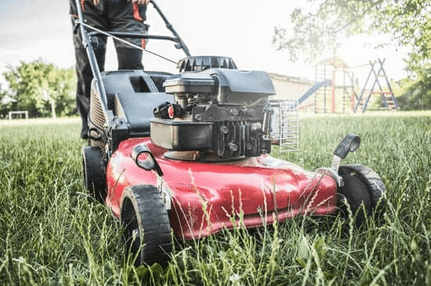Simple tips to keep your lawn healthy and green in the heat:

As summer gets closer, lawn care becomes a big deal. Your lawn will face heat stress and drought challenges. It's crucial to know how to handle these.
To keep your lawn healthy, you need to prepare it well. This means fighting off the heat and water shortages. Mowing at the right height and fertilizing correctly can help your lawn survive the summer.
I'll share important tips on summer lawn maintenance. This way, your lawn will stay green and lively all season long.
Key Takeaways
- Maintain your lawn at the right height to withstand heat stress
- Fertilize your lawn to promote healthy growth
- Understand the challenges your lawn may face during hot weather
- Take steps to mitigate the effects of drought on your lawn
- Implement effective summer lawn maintenance strategies
Understanding Summer Lawn Challenges
Understanding the summer lawn challenges is crucial for keeping your lawn healthy. As the weather gets hotter, lawns face many issues that can harm their health and look.
Heat Stress and Its Effects on Grass
Heat stress is a big problem for lawns in summer. High temperatures can make grass stressed, leading to:
- Dryness and brittleness
- Discoloration
- Increased susceptibility to pests and diseases
Heat stress happens when grass is in high temperatures for too long. It struggles to make food and keep water. This stress gets worse with drought, poor soil, and bad lawn care.
Common Summer Lawn Problems
Lawns also face other summer issues. These include:
- Drought: Not enough rain can cause drought, stressing the lawn more.
- Pest infestations: Summer is when pests like grubs and chinch bugs harm lawns.
- Diseases: Fungal diseases like powdery mildew and rust can infect grass in summer.
Effective lawn care in summer means tackling these problems early. By knowing the issues and taking action, homeowners can keep their lawn healthy and green all season.
Assessing Your Lawn's Current Condition

Checking your lawn's health is key to keeping it through summer. You need to know your grass type, its heat tolerance, and soil quality.
Identifying Grass Types and Their Heat Tolerance
Grasses vary in how well they handle heat. Cool-season grasses and warm-season grasses are the main types. Cool-season grasses do best in cooler weather and often go dormant in summer. Warm-season grasses can handle more heat but still need care.
Cool-Season vs. Warm-Season Grasses
Cool-season grasses like Kentucky bluegrass and perennial ryegrass prefer temperatures between 60°F and 75°F. They need more care in summer, including regular watering and mowing. Warm-season grasses, such as Bermudagrass and zoysiagrass, do well in temperatures over 80°F and are more drought-resistant.
Knowing if your lawn is cool-season or warm-season is key. Cool-season grasses might need more water in summer, while warm-season grasses can get by with less.
Soil Testing and Analysis
Soil testing is crucial for lawn health. It shows the soil's pH level and nutrient content, vital for grass growth. You can buy a soil testing kit or get help from a local nursery or lawn care expert.
A soil test can show if your soil lacks nutrients like nitrogen, phosphorus, and potassium. Based on the results, you can add the right fertilizers to improve your soil's health.
"Soil testing is a vital step in lawn care. It provides valuable information about the soil's condition, allowing homeowners to make informed decisions about fertilization and other care strategies." - Lawn Care Expert
| Grass Type | Heat Tolerance | Watering Needs |
|---|---|---|
| Cool-Season Grasses | Low-Moderate | High |
| Warm-Season Grasses | High | Moderate-Low |
By understanding your lawn's current state, including grass type and soil quality, you can create a good care plan. This will help your lawn stay healthy and survive the summer heat.
How to Prepare Your Lawn for a Hot Summer

To keep your lawn healthy in the hot summer, start early. Preparing your lawn is key to its health and strength during dry months.
Early Spring Preparation Steps
Early spring is crucial for lawn prep. Begin by fertilizing your lawn with a balanced mix. This gives it the nutrients it needs.
Also, mow your lawn at a higher height. This encourages deep roots and shades the soil, fighting weeds.
- Apply a pre-emergent herbicide to stop crabgrass and weeds.
- Overseed bare spots for a lush look.
Late Spring Preparation Tasks
As late spring comes, focus on summer-ready tasks. Aerating your lawn is essential. It improves drainage, reduces compaction, and boosts root health.
Building Drought Resistance
It's vital to make your lawn drought-resistant for summer. Use proper mowing, watering, and soil care.
Aerating Your Lawn
Aerating lets your lawn breathe. It makes the soil absorb water and nutrients better. This process creates holes in the soil for better root growth.
"Aerating your lawn is like giving it a breath of fresh air. It helps the soil absorb the necessary nutrients and water, making it more resilient to drought." - Lawn Care Expert
Applying Mulch and Compost
Using mulch and compost boosts drought resistance. Mulch keeps moisture in, fights weeds, and controls soil temperature. Compost adds nutrients and improves soil structure.
- Spread organic mulch around plants and trees.
- Mix compost into the soil for better water retention.
By taking these steps, your lawn will stay healthy and green all summer.
Watering Strategies for Summer Heat
To keep your lawn thriving in the summer, it's key to know the best watering methods. Proper watering keeps your lawn healthy and looking good. It also helps save water.
Optimal Watering Times and Techniques
Watering at the right time is crucial for your lawn to handle summer heat. Watering in the early morning is best. This way, the water can soak into the soil before it evaporates.
It's also important to water deeply but not too often. This encourages your lawn to grow strong roots. Strong roots help your lawn survive without much water.
Tips for Effective Watering:
- Water between 6 AM and 10 AM to minimize evaporation.
- Avoid watering in the evening as it can lead to fungal growth.
- Use a rain gauge or a moisture sensor to determine if your lawn needs watering.
Setting Up an Efficient Irrigation System
An efficient irrigation system delivers water right to your lawn's roots. This cuts down on waste and runoff. Think about getting a smart irrigation controller. It adjusts watering based on the weather.
Water Conservation Tips
Conserving water is good for the environment and saves you money. Here are some tips to keep your lawn healthy while saving water:
| Tip | Description | Benefit |
|---|---|---|
| Mow high | Maintain your mower at a higher setting | Reduces water loss through transpiration |
| Avoid overwatering | Water only when necessary | Prevents water waste and root rot |
| Use drought-tolerant grass | Choose grass species that require less water | Reduces the need for frequent watering |
By using these watering strategies, you can keep your lawn healthy and green all summer. You'll also save water.
Mowing and Maintenance During Hot Weather

To keep your lawn thriving in the summer, focus on the right mowing and care. It's key to keep your lawn healthy and alive during this time.
Proper Mowing Heights for Summer
Changing your mowing height with the seasons is crucial. Taller grass shades the soil, cutting down on water loss and weed growth. For cool-season grasses, keep it at 3-4 inches. Warm-season grasses should be 2-3 inches tall.
Fertilization and Weed Control
Fertilizing and controlling weeds are vital in summer. Proper fertilization helps your grass grow well. Effective weed control stops weeds from taking over your lawn's water and nutrients.
Summer-Safe Fertilizers
Choosing the right fertilizers in summer is key. Opt for slow-release fertilizers that feed your lawn over time. Stay away from high-nitrogen fertilizers, as they can harm your grass in the heat.
Targeted Weed Management
Weeds can be a big problem in summer. Use targeted weed management by identifying weeds and treating them with the right herbicides or by removing them by hand.
Dealing with Summer Pests
Summer brings pests that can harm your lawn. Common pests include chinch bugs, billbugs, and white grubs. Keep an eye out for them and use integrated pest management techniques to fight infestations.
Conclusion
Follow the tips and strategies in this article to keep your lawn healthy and green all summer. Proper lawn care is key to a lush lawn during the hot months.
Good summer lawn care involves checking your lawn's health, preparing it for the heat, and saving water. Know your grass type, test your soil, and adjust how you water and mow.
By using these lawn care tips, you'll have a beautiful lawn all summer. A healthy lawn makes your outdoor space better and safer for fun and relaxation.
FAQ
Q: What are the most common summer lawn problems?
A: Summer lawn problems include heat stress, drought, pests, and weeds. Knowing these issues helps with effective lawn care.
Q: How do I identify my grass type and its heat tolerance?
A: Look at your grass's shape, color, and texture to identify it. Cool-season grasses like Kentucky bluegrass are more sensitive to heat. Warm-season grasses like Bermudagrass are more heat-tolerant.
Q: Why is soil testing important for summer lawn care?
A: Soil testing shows what nutrients your lawn needs. This lets you use the right fertilizers and amendments. Your lawn will get the nutrients it needs to thrive in summer.
Q: What are the best early spring preparation steps for summer lawn care?
A: Start by fertilizing with a balanced fertilizer. Mow high to help your lawn grow. Also, control weeds early on.
Q: How often should I water my lawn during the summer?
A: Water deeply but not too often. This encourages deep roots. The right frequency depends on your climate, soil, and grass. Aim for 1-2 inches of water per week.
Q: What is the best way to control weeds during the summer?
A: Use cultural, mechanical, and chemical controls. Keep mowing heights right, remove weeds by hand, and use herbicides when needed.
Q: How can I prevent heat stress in my lawn?
A: Prevent heat stress by mowing at the right height and watering deeply but less often. Also, provide shade if possible.
Q: What type of fertilizer should I use during the summer?
A: Use a summer-safe fertilizer with lots of potassium and phosphorus. This helps with growth and drought resistance. Avoid nitrogen-heavy fertilizers.
Q: How can I conserve water while maintaining a healthy lawn?
A: Use drought-tolerant grasses and keep mowing heights right. Water efficiently with a rain sensor or drip irrigation system.
DISCLAIMER
This document is provided for general information purposes only and should not be relied upon as providing legal advice, technical, or specific operational guidance to the reader, whether as to the practices described in the document or the applicable legal requirements and regulations. Lawnfly.com expressly disclaims any responsibility for liability arising from or related to the use or misuse of any information in this document.



